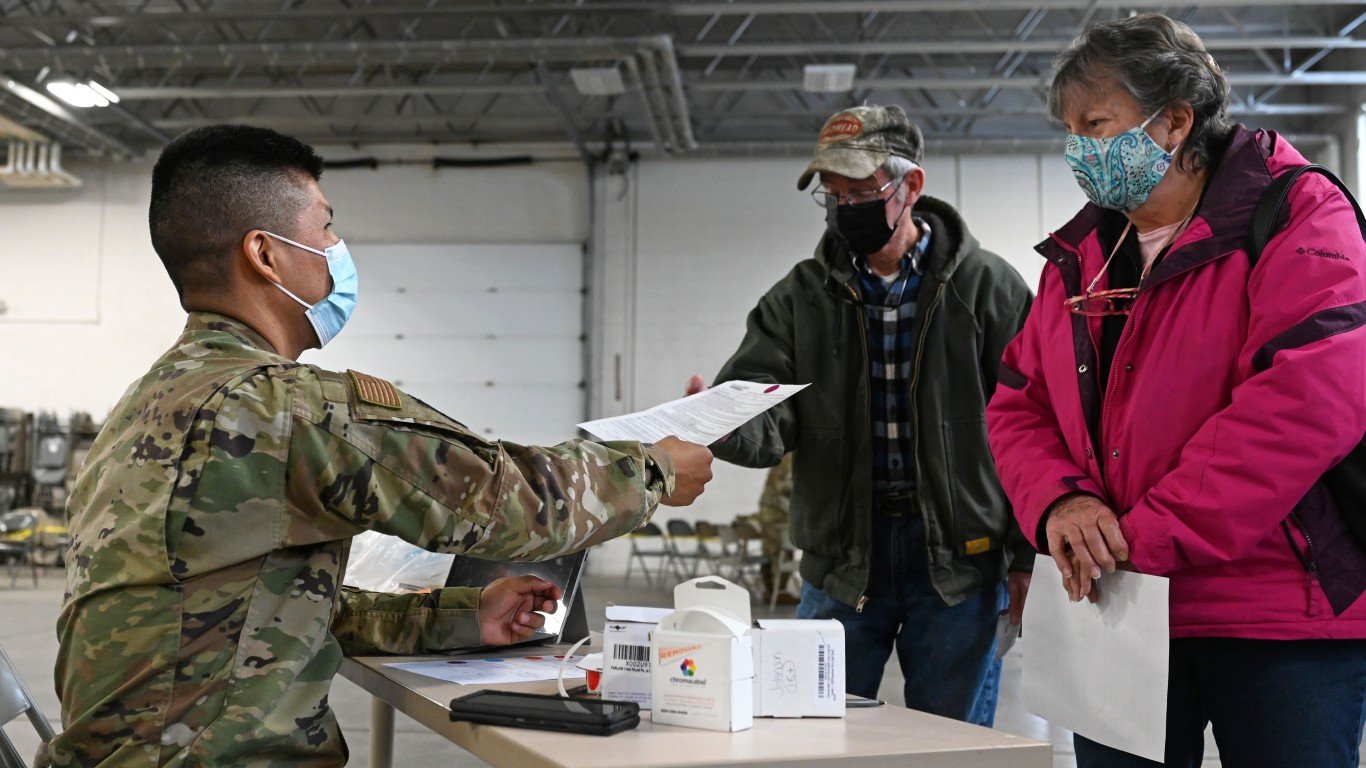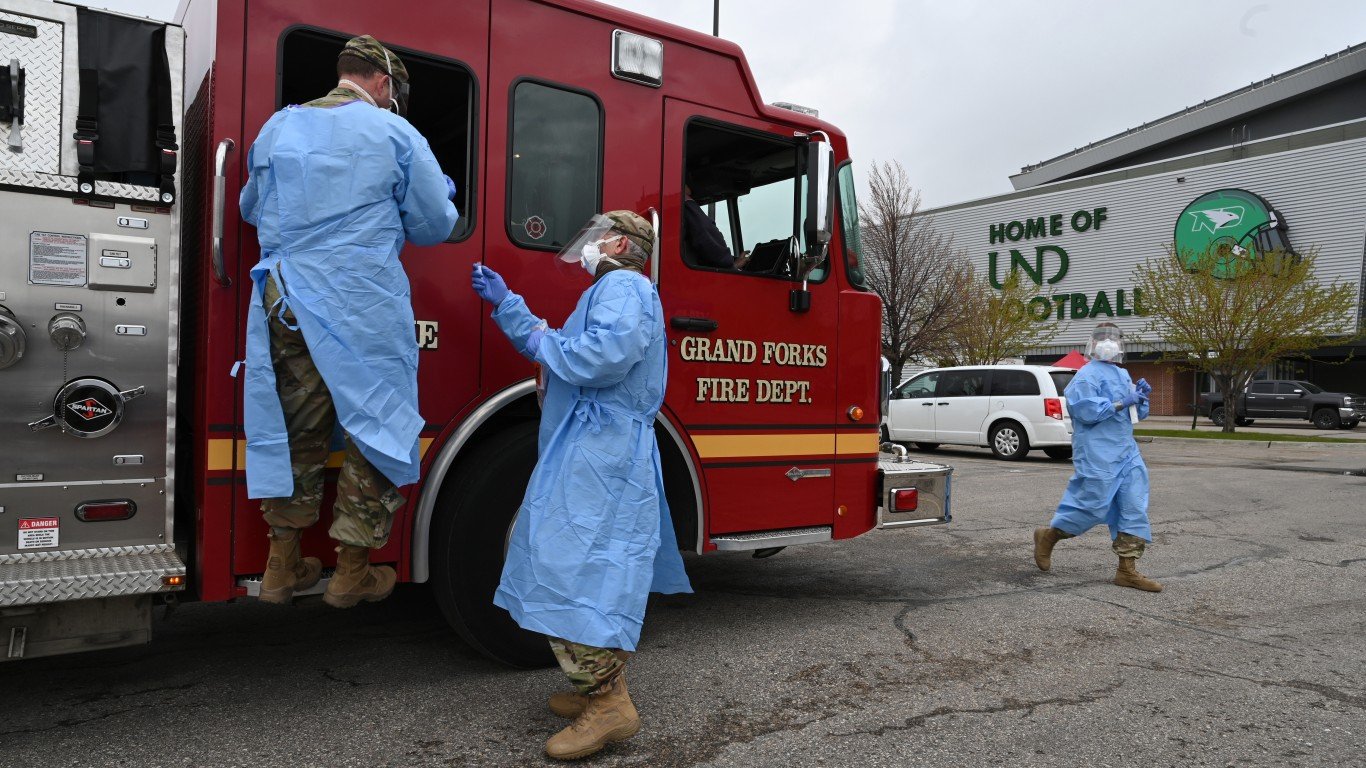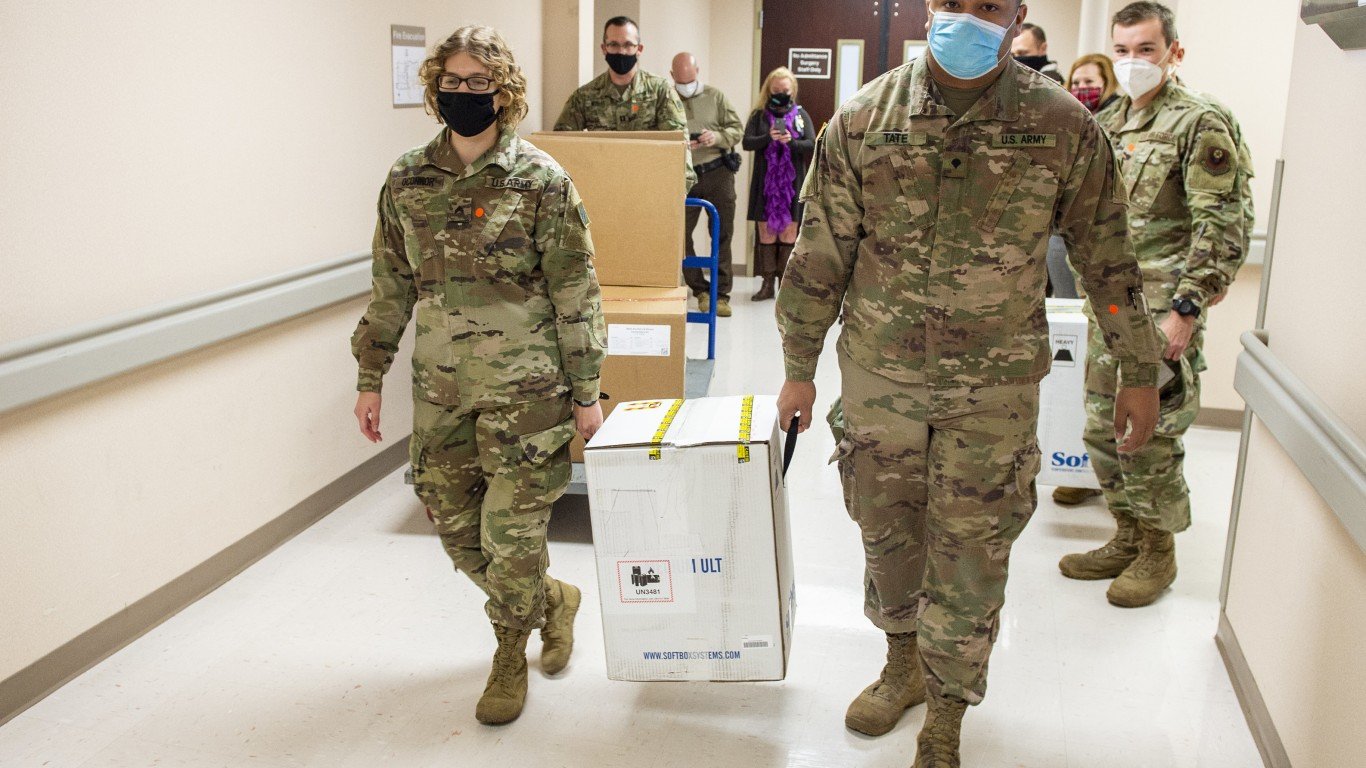

The federal government officially ended the COVID-19 public health emergency on Thursday, May 11, more than three years after the outbreak caused massive disruption in the U.S. Various pandemic-related rules and waivers will come to an end as a result.
As the public health emergency is lifted, Americans are taking a sobering look at the lives lost and what parts of the country were hit the hardest.
To find the states with the most deaths per capita from COVID-19, 24/7 Tempo reviewed data from the Centers for Disease Control and Prevention, last updated on May 10, 2023. States are ordered by the number of COVID-related deaths per 100,000 people. All data is from the CDC except population figures, which come from the U.S. Census Bureau’s 2021 American Community Survey, and were not used to calculate death and case rates. (Data for New York state was extrapolated from the CDC data for the state and New York City and is an estimate.) The CDC has noted that its ability to collect and share certain data will change due to the end of the emergency.
As of May 10, there have been 1,131,819 total deaths from COVID-19 in the United States, according to the CDC. The national death rate was 340 people per 100,000. Thirty states had death rates above the national average.
Eight of the 10 states with the highest death rates are in the South. Many Southern states saw a surge in cases in June 2020 after they relaxed COVID-19 restrictions too soon, according to Robert Redfield, a former director of the CDC. The Southwestern states of New Mexico and Arizona were also among the top 10.
States such as California, Michigan, and Rhode Island had some of the tightest restrictions during the outbreak, yet they had among the highest numbers of total deaths, cases per 100,000, and total cases. (Here’s a reminder that the rapidly spreading new Arcturus COVID strain has been detected in at least 20 states.)
Some of the least populous states – Vermont, Alaska, and Wyoming – had among the lowest total deaths, cases per 100,000, and total cases. Maryland had the lowest number of cases per 100,000, and Oregon was second.
Click here to see the states with the most deaths per capita from COVID-19
What does the end of the COVID-19 emergency mean for the country?
The government is revoking Title 42, a law that allows the U.S. to deny asylum and migration claims for public health reasons – though a federal judge in Florida has temporarily blocked the government from following through with its plan.
Work requirements for federal food assistance programs that were halted during the emergency will return in about two dozen states. (See the places where the most people use food stamps in every state.)
The government will stop covering the costs for COVID-19 vaccines. Instead the treatments will either be covered by private medical insurance or people may have to pay out of pocket. COVID-19 at-home tests may no longer be covered by insurance, and those on Medicare will no longer be able to get free eight rapid over-the-counter COVID-19 tests.
Patients will again have to spend three straight days in a hospital before they’re eligible to go to a skilled nursing facility.
The government will also reduce the frequency with which it tracks COVID-19. CDC surveillance will focus on deaths as opposed to cases, test positivity rates, and post-vaccination health check-ins.
In states where the governor exercised powers due to the declaration of a health emergency, those powers are also ended.

50. Hawaii
> Death rate: 130 per 100,000
> Total deaths: 1,852 – 3rd lowest
> Cases per 100,000: 26,387 – 6th lowest
> Total cases: 373,610 – 9th lowest
> Population, 2021: 1,441,553 – 11th lowest
[in-text-ad]

49. Vermont
> Death rate: 154 per 100,000
> Total deaths: 962 – the lowest
> Cases per 100,000: 24,707 – 4th lowest
> Total cases: 154,169 – the lowest
> Population, 2021: 645,570 – 2nd lowest

48. Utah
> Death rate: 167 per 100,000
> Total deaths: 5,354 – 13th lowest
> Cases per 100,000: 34,212 – 14th highest
> Total cases: 1,096,820 – 23rd lowest
> Population, 2021: 3,337,975 – 21st lowest
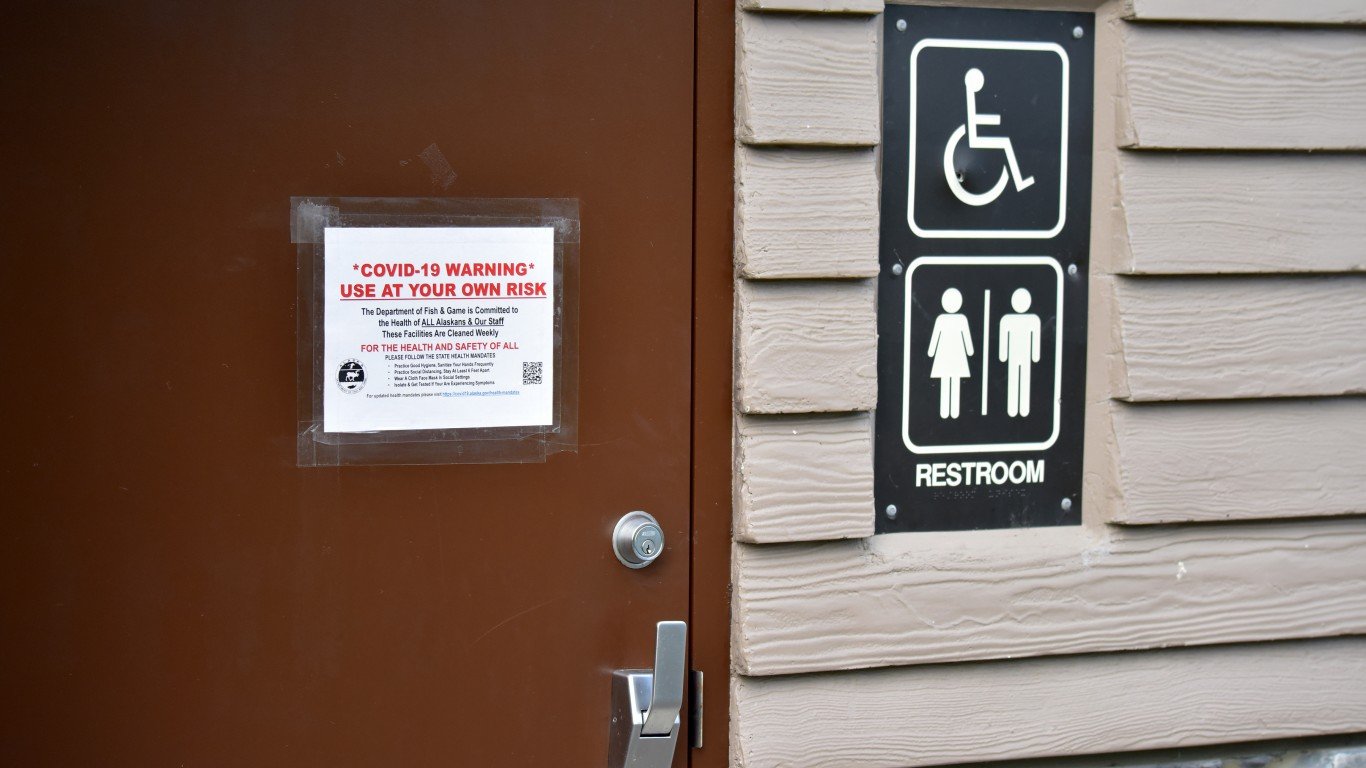
47. Alaska
> Death rate: 200 per 100,000
> Total deaths: 1,468 – 2nd lowest
> Cases per 100,000: 40,652 – 2nd highest
> Total cases: 297,389 – 5th lowest
> Population, 2021: 732,673 – 3rd lowest
[in-text-ad-2]

46. Washington
> Death rate: 212 per 100,000
> Total deaths: 16,151 – 24th highest
> Cases per 100,000: 25,688 – 5th lowest
> Total cases: 1,956,105 – 18th highest
> Population, 2021: 7,738,692 – 13th highest
45. New Hampshire
> Death rate: 224 per 100,000
> Total deaths: 3,046 – 7th lowest
> Cases per 100,000: 28,074 – 10th lowest
> Total cases: 381,732 – 10th lowest
> Population, 2021: 1,388,992 – 10th lowest
[in-text-ad]

44. Maine
> Death rate: 225 per 100,000
> Total deaths: 3,028 – 6th lowest
> Cases per 100,000: 24,008 – 3rd lowest
> Total cases: 322,720 – 6th lowest
> Population, 2021: 1,372,247 – 9th lowest

43. Oregon
> Death rate: 226 per 100,000
> Total deaths: 9,544 – 17th lowest
> Cases per 100,000: 23,115 – 2nd lowest
> Total cases: 974,924 – 19th lowest
> Population, 2021: 4,246,155 – 24th lowest
42. Colorado
> Death rate: 249 per 100,000
> Total deaths: 14,371 – 24th lowest
> Cases per 100,000: 30,937 – 20th lowest
> Total cases: 1,781,579 – 22nd highest
> Population, 2021: 5,812,069 – 21st highest
[in-text-ad-2]

41. California
> Death rate: 257 per 100,000
> Total deaths: 101,785 – the highest
> Cases per 100,000: 30,984 – 21st lowest
> Total cases: 12,242,634 – the highest
> Population, 2021: 39,237,836 – the highest

39. Minnesota
> Death rate: 261 per 100,000
> Total deaths: 14,747 – 25th lowest
> Cases per 100,000: 31,821 – 24th lowest
> Total cases: 1,794,570 – 20th highest
> Population, 2021: 5,707,390 – 22nd highest
[in-text-ad]
39. Nebraska
> Death rate: 261 per 100,000
> Total deaths: 5,065 – 12th lowest
> Cases per 100,000: 29,713 – 18th lowest
> Total cases: 574,777 – 13th lowest
> Population, 2021: 1,963,692 – 14th lowest

37. Maryland
> Death rate: 276 per 100,000
> Total deaths: 16,727 – 22nd highest
> Cases per 100,000: 22,797 – the lowest
> Total cases: 1,378,226 – 25th lowest
> Population, 2021: 6,165,129 – 19th highest
37. North Carolina
> Death rate: 276 per 100,000
> Total deaths: 28,986 – 13th highest
> Cases per 100,000: 33,363 – 18th highest
> Total cases: 3,499,147 – 7th highest
> Population, 2021: 10,551,162 – 9th highest
[in-text-ad-2]

36. Virginia
> Death rate: 278 per 100,000
> Total deaths: 23,743 – 16th highest
> Cases per 100,000: 27,060 – 7th lowest
> Total cases: 2,309,667 – 14th highest
> Population, 2021: 8,642,274 – 12th highest
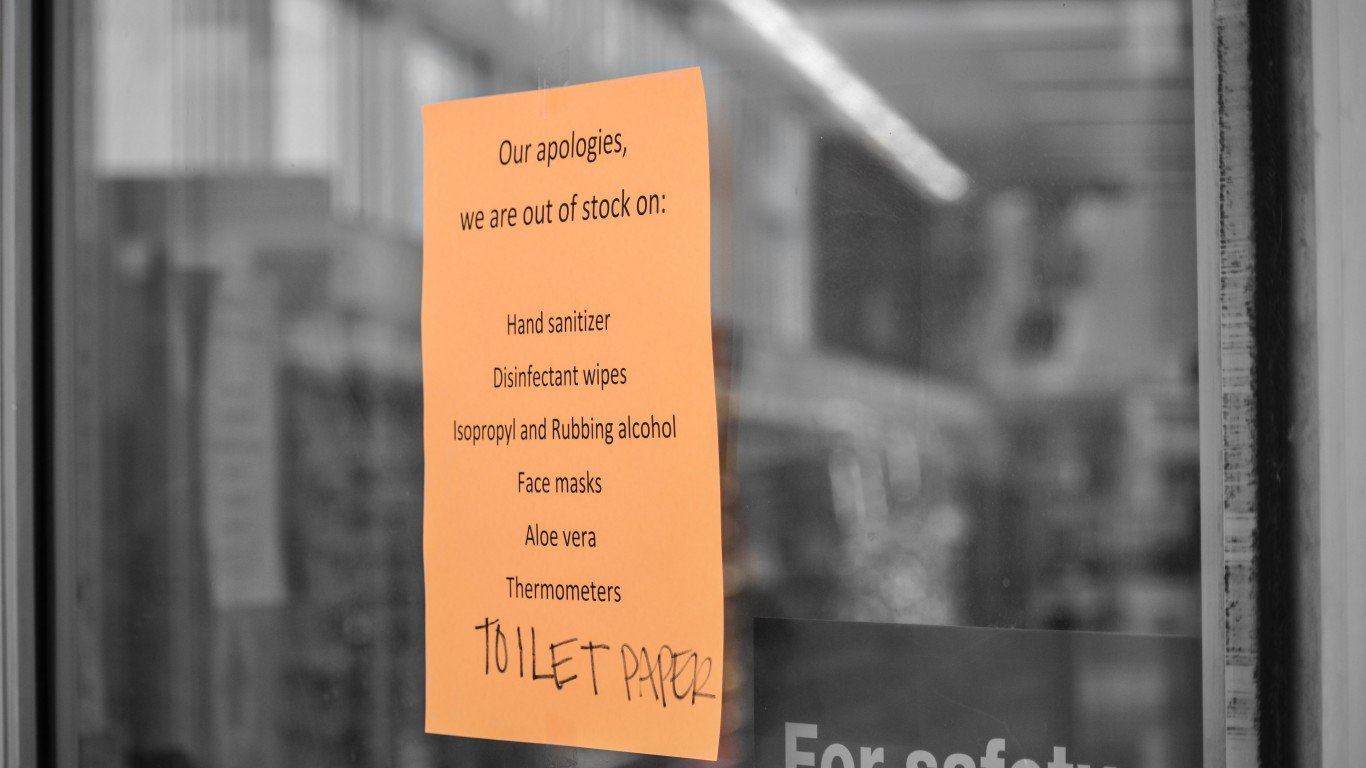
35. Wisconsin
> Death rate: 284 per 100,000
> Total deaths: 16,590 – 23rd highest
> Cases per 100,000: 34,851 – 10th highest
> Total cases: 2,029,196 – 17th highest
> Population, 2021: 5,895,908 – 20th highest
[in-text-ad]

34. Idaho
> Death rate: 306 per 100,000
> Total deaths: 5,482 – 14th lowest
> Cases per 100,000: 29,424 – 17th lowest
> Total cases: 525,825 – 12th lowest
> Population, 2021: 1,900,923 – 13th lowest

33. Texas
> Death rate: 323 per 100,000
> Total deaths: 93,739 – 2nd highest
> Cases per 100,000: 29,323 – 15th lowest
> Total cases: 8,502,584 – 2nd highest
> Population, 2021: 29,527,941 – 2nd highest
32. North Dakota
> Death rate: 329 per 100,000
> Total deaths: 2,511 – 5th lowest
> Cases per 100,000: 38,145 – 4th highest
> Total cases: 290,687 – 4th lowest
> Population, 2021: 774,948 – 4th lowest
[in-text-ad-2]
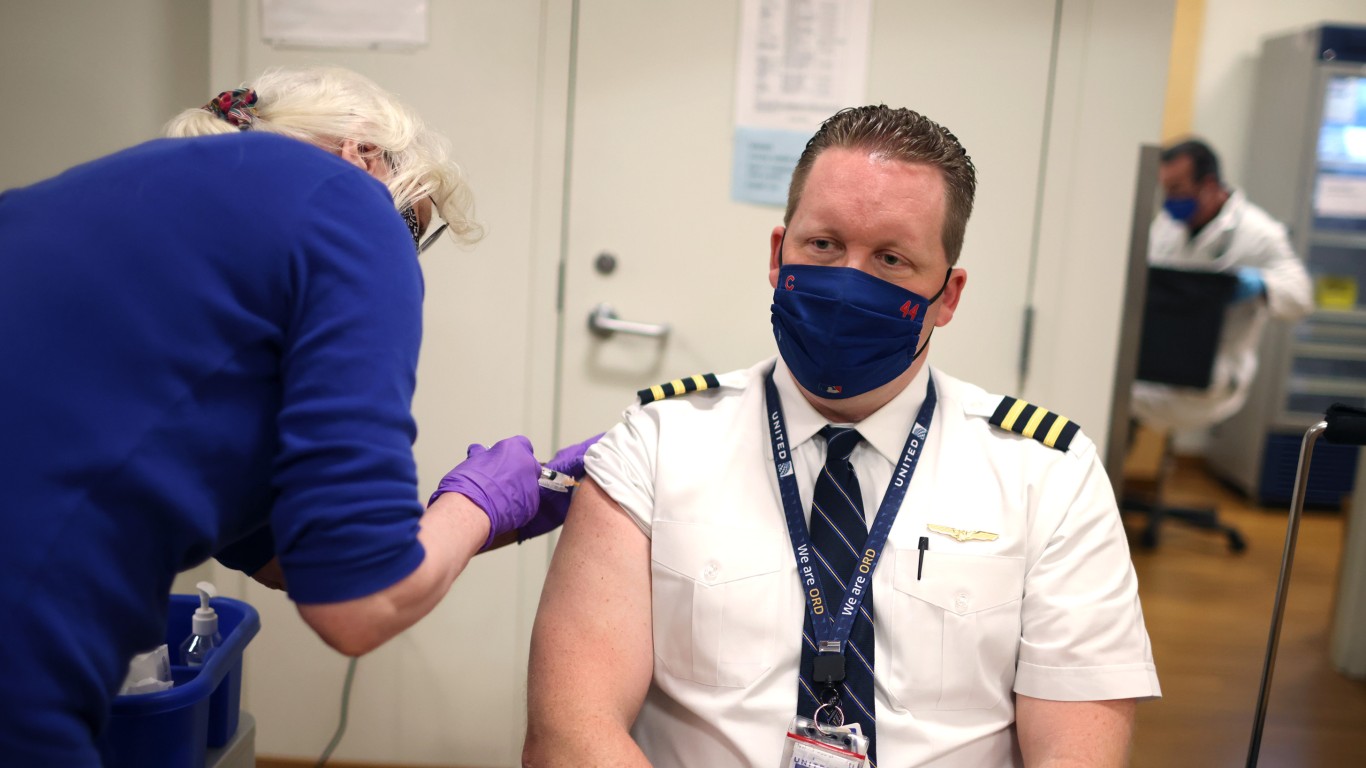
31. Illinois
> Death rate: 331 per 100,000
> Total deaths: 42,005 – 9th highest
> Cases per 100,000: 32,638 – 21st highest
> Total cases: 4,135,809 – 5th highest
> Population, 2021: 12,671,469 – 6th highest
30. Iowa
> Death rate: 342 per 100,000
> Total deaths: 10,797 – 19th lowest
> Cases per 100,000: 28,809 – 11th lowest
> Total cases: 908,936 – 17th lowest
> Population, 2021: 3,193,079 – 20th lowest
[in-text-ad]

29. Connecticut
> Death rate: 345 per 100,000
> Total deaths: 12,334 – 21st lowest
> Cases per 100,000: 27,540 – 8th lowest
> Total cases: 981,895 – 20th lowest
> Population, 2021: 3,605,597 – 22nd lowest

28. Montana
> Death rate: 347 per 100,000
> Total deaths: 3,713 – 10th lowest
> Cases per 100,000: 31,228 – 23rd lowest
> Total cases: 333,759 – 8th lowest
> Population, 2021: 1,104,271 – 8th lowest
27. Delaware
> Death rate: 348 per 100,000
> Total deaths: 3,394 – 9th lowest
> Cases per 100,000: 34,273 – 13th highest
> Total cases: 333,738 – 7th lowest
> Population, 2021: 1,003,384 – 6th lowest
[in-text-ad-2]
26. Kansas
> Death rate: 349 per 100,000
> Total deaths: 10,196 – 18th lowest
> Cases per 100,000: 32,452 – 23rd highest
> Total cases: 945,438 – 18th lowest
> Population, 2021: 2,934,582 – 16th lowest
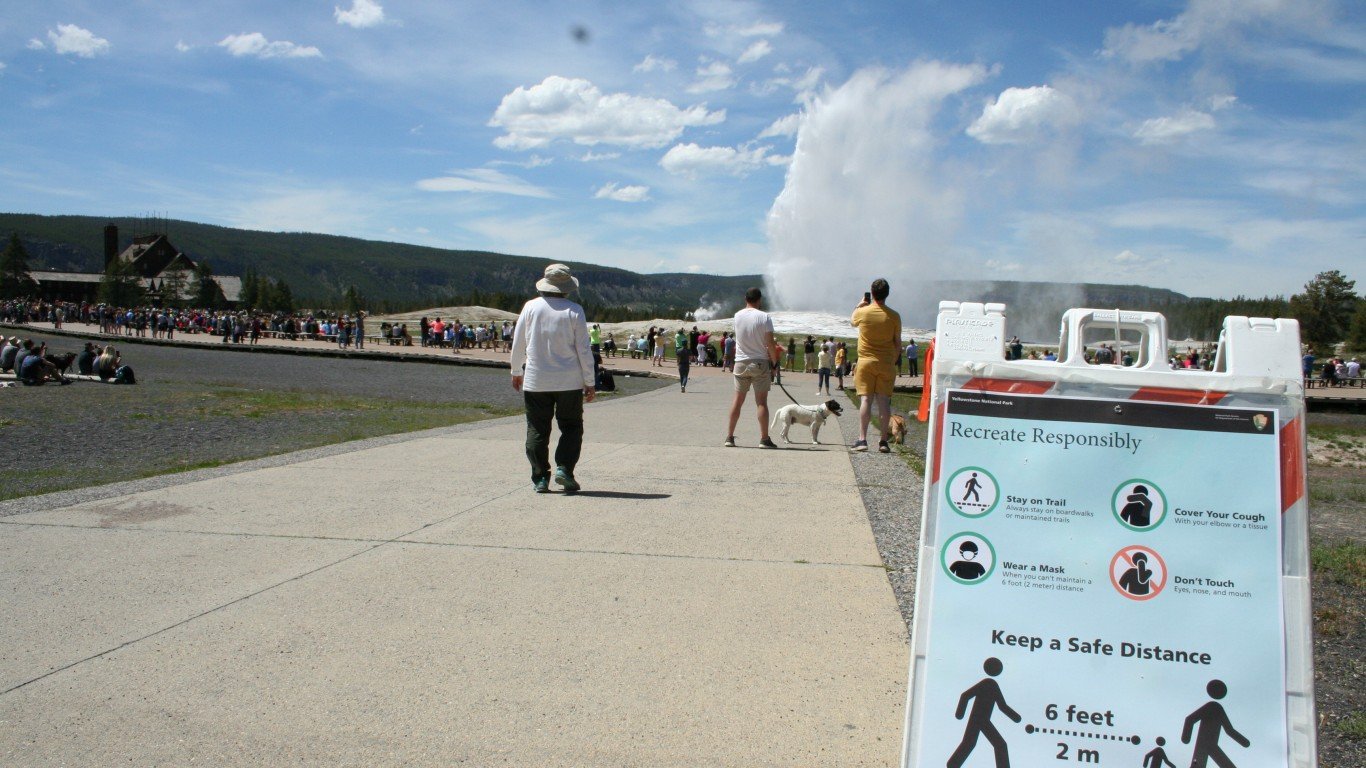
25. Wyoming
> Death rate: 350 per 100,000
> Total deaths: 2,031 – 4th lowest
> Cases per 100,000: 32,256 – 25th highest
> Total cases: 186,685 – 2nd lowest
> Population, 2021: 578,803 – the lowest
[in-text-ad]

24. Massachusetts
> Death rate: 357 per 100,000
> Total deaths: 24,629 – 15th highest
> Cases per 100,000: 32,513 – 22nd highest
> Total cases: 2,240,955 – 15th highest
> Population, 2021: 6,984,723 – 15th highest

23. Ohio
> Death rate: 360 per 100,000
> Total deaths: 42,168 – 8th highest
> Cases per 100,000: 29,416 – 16th lowest
> Total cases: 3,438,480 – 8th highest
> Population, 2021: 11,780,017 – 7th highest

22. South Dakota
> Death rate: 365 per 100,000
> Total deaths: 3,229 – 8th lowest
> Cases per 100,000: 31,953 – 25th lowest
> Total cases: 282,679 – 3rd lowest
> Population, 2021: 895,376 – 5th lowest
[in-text-ad-2]

21. Rhode Island
> Death rate: 369 per 100,000
> Total deaths: 3,914 – 11th lowest
> Cases per 100,000: 41,643 – the highest
> Total cases: 441,153 – 11th lowest
> Population, 2021: 1,095,610 – 7th lowest

20. Missouri
> Death rate: 373 per 100,000
> Total deaths: 22,908 – 17th highest
> Cases per 100,000: 29,147 – 13th lowest
> Total cases: 1,788,856 – 21st highest
> Population, 2021: 6,168,187 – 18th highest
[in-text-ad]
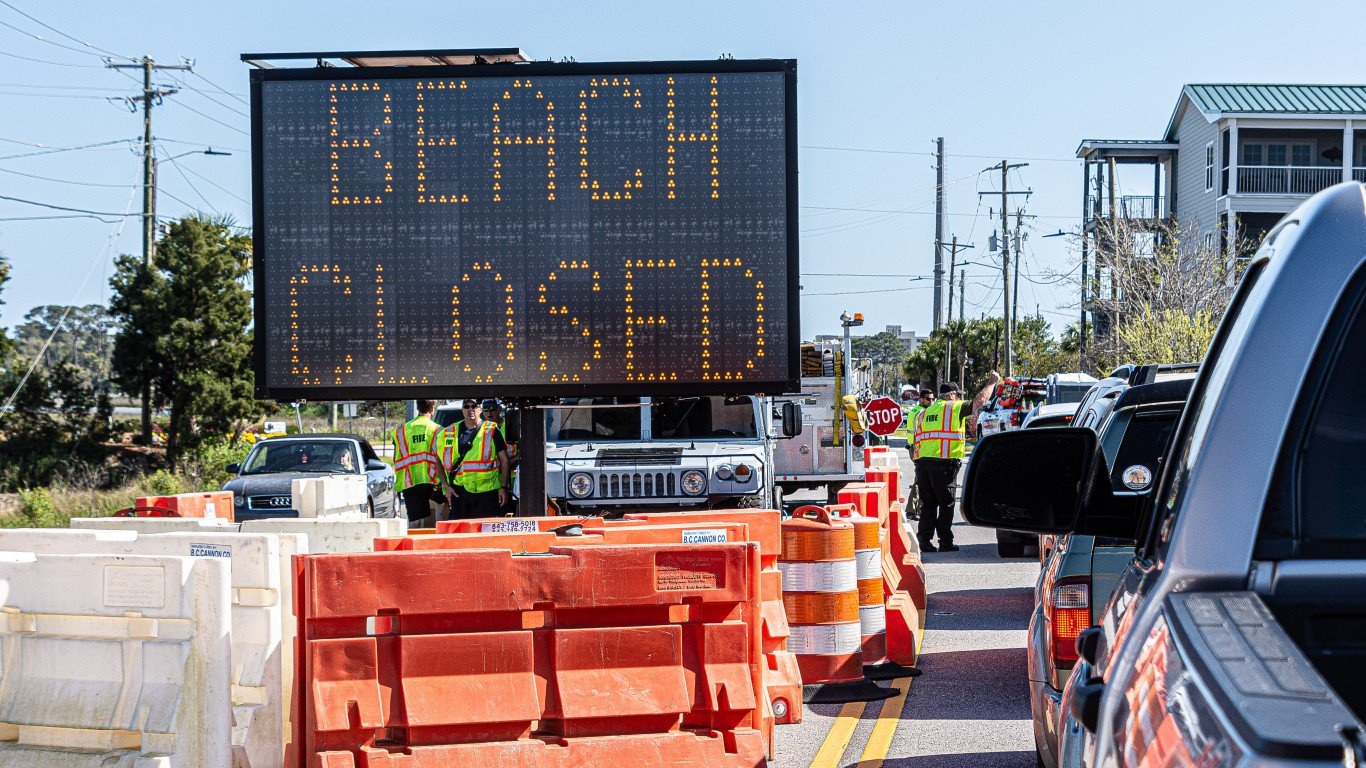
19. South Carolina
> Death rate: 386 per 100,000
> Total deaths: 19,903 – 19th highest
> Cases per 100,000: 35,944 – 7th highest
> Total cases: 1,850,662 – 19th highest
> Population, 2021: 5,190,705 – 23rd highest

18. Nevada
> Death rate: 389 per 100,000
> Total deaths: 11,998 – 20th lowest
> Cases per 100,000: 29,150 – 14th lowest
> Total cases: 897,871 – 16th lowest
> Population, 2021: 3,143,991 – 19th lowest

17. Indiana
> Death rate: 392 per 100,000
> Total deaths: 26,421 – 14th highest
> Cases per 100,000: 30,816 – 19th lowest
> Total cases: 2,074,635 – 16th highest
> Population, 2021: 6,805,985 – 17th highest
[in-text-ad-2]

16. New York
> Death rate: 397.81094754653856 per 100,000
> Total deaths: 77,478 – 4th highest
> Cases per 100,000: 35,136 – 8th highest
> Total cases: 6,835,037 – 4th highest
> Population, 2021: 19,835,913 – 4th highest

15. Pennsylvania
> Death rate: 398 per 100,000
> Total deaths: 51,042 – 5th highest
> Cases per 100,000: 27,788 – 9th lowest
> Total cases: 3,557,354 – 6th highest
> Population, 2021: 12,964,056 – 5th highest
[in-text-ad]

14. Georgia
> Death rate: 402 per 100,000
> Total deaths: 42,768 – 7th highest
> Cases per 100,000: 29,067 – 12th lowest
> Total cases: 3,086,132 – 10th highest
> Population, 2021: 10,799,566 – 8th highest
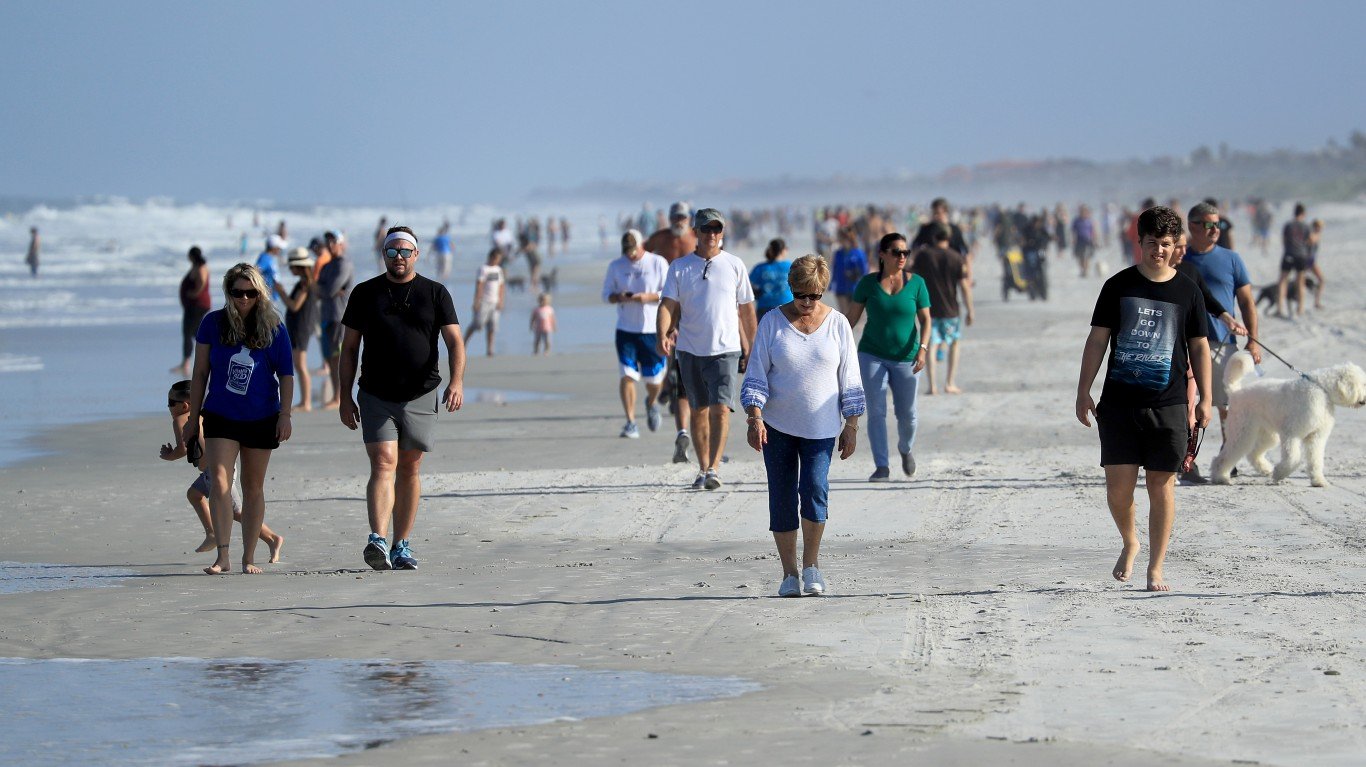
13. Florida
> Death rate: 405 per 100,000
> Total deaths: 87,141 – 3rd highest
> Cases per 100,000: 35,120 – 9th highest
> Total cases: 7,542,869 – 3rd highest
> Population, 2021: 21,781,128 – 3rd highest

12. New Jersey
> Death rate: 406 per 100,000
> Total deaths: 36,117 – 10th highest
> Cases per 100,000: 34,604 – 11th highest
> Total cases: 3,073,628 – 11th highest
> Population, 2021: 9,267,130 – 11th highest
[in-text-ad-2]

10. Louisiana
> Death rate: 407 per 100,000
> Total deaths: 18,956 – 20th highest
> Cases per 100,000: 34,400 – 12th highest
> Total cases: 1,599,190 – 25th highest
> Population, 2021: 4,624,047 – 25th highest
10. Oklahoma
> Death rate: 407 per 100,000
> Total deaths: 16,119 – 25th highest
> Cases per 100,000: 32,990 – 19th highest
> Total cases: 1,305,398 – 24th lowest
> Population, 2021: 3,986,639 – 23rd lowest
[in-text-ad]

9. Kentucky
> Death rate: 415 per 100,000
> Total deaths: 18,567 – 21st highest
> Cases per 100,000: 38,957 – 3rd highest
> Total cases: 1,740,457 – 23rd highest
> Population, 2021: 4,509,394 – 25th lowest
8. Michigan
> Death rate: 428 per 100,000
> Total deaths: 42,812 – 6th highest
> Cases per 100,000: 31,077 – 22nd lowest
> Total cases: 3,103,644 – 9th highest
> Population, 2021: 10,050,811 – 10th highest
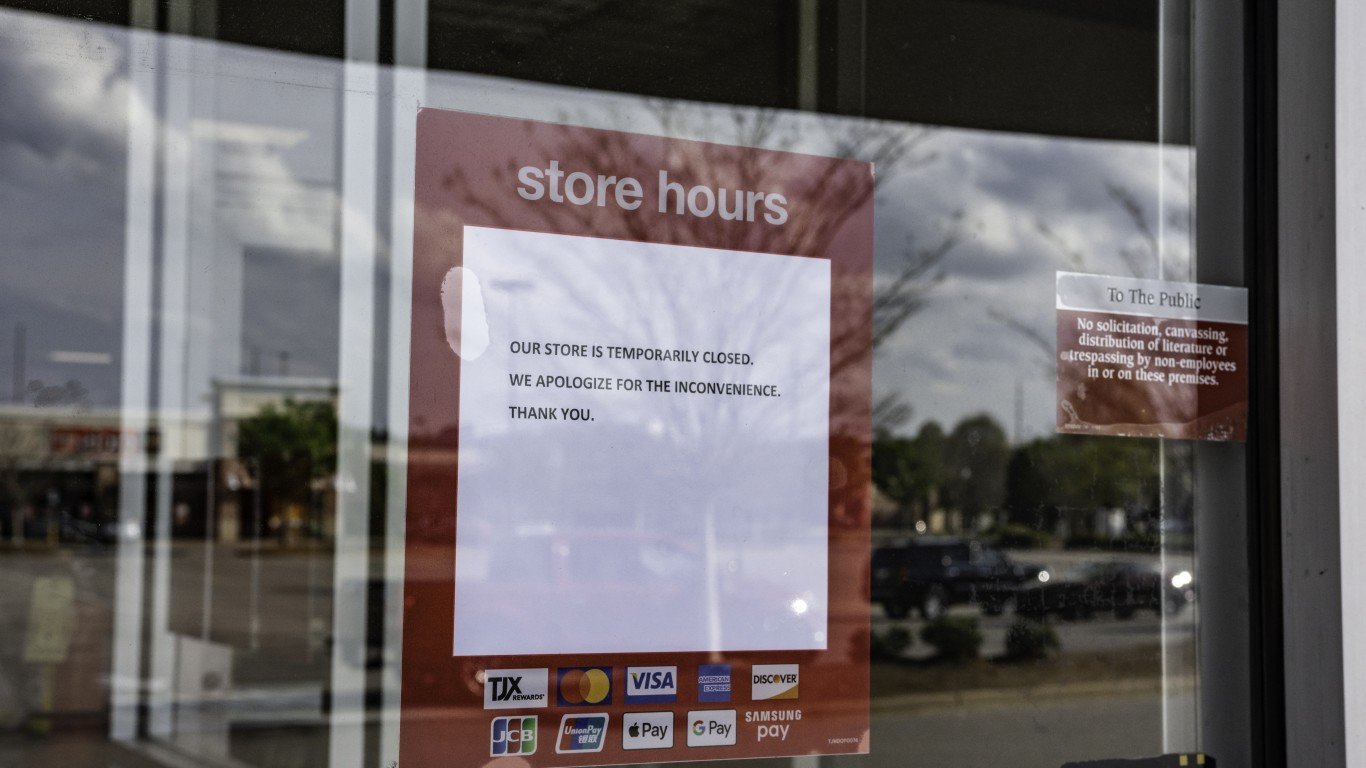
7. Alabama
> Death rate: 431 per 100,000
> Total deaths: 21,137 – 18th highest
> Cases per 100,000: 33,828 – 16th highest
> Total cases: 1,658,639 – 24th highest
> Population, 2021: 5,039,877 – 24th highest
[in-text-ad-2]

6. Tennessee
> Death rate: 432 per 100,000
> Total deaths: 29,515 – 12th highest
> Cases per 100,000: 37,180 – 5th highest
> Total cases: 2,539,120 – 12th highest
> Population, 2021: 6,975,218 – 16th highest

5. Arkansas
> Death rate: 434 per 100,000
> Total deaths: 13,115 – 22nd lowest
> Cases per 100,000: 32,951 – 20th highest
> Total cases: 994,386 – 21st lowest
> Population, 2021: 3,025,891 – 18th lowest
[in-text-ad]

4. New Mexico
> Death rate: 440 per 100,000
> Total deaths: 9,236 – 16th lowest
> Cases per 100,000: 32,451 – 24th highest
> Total cases: 680,438 – 15th lowest
> Population, 2021: 2,115,877 – 15th lowest
3. Mississippi
> Death rate: 451 per 100,000
> Total deaths: 13,447 – 23rd lowest
> Cases per 100,000: 33,554 – 17th highest
> Total cases: 998,627 – 22nd lowest
> Population, 2021: 2,949,965 – 17th lowest
2. West Virginia
> Death rate: 452 per 100,000
> Total deaths: 8,117 – 15th lowest
> Cases per 100,000: 36,290 – 6th highest
> Total cases: 650,363 – 14th lowest
> Population, 2021: 1,782,959 – 12th lowest
[in-text-ad-2]
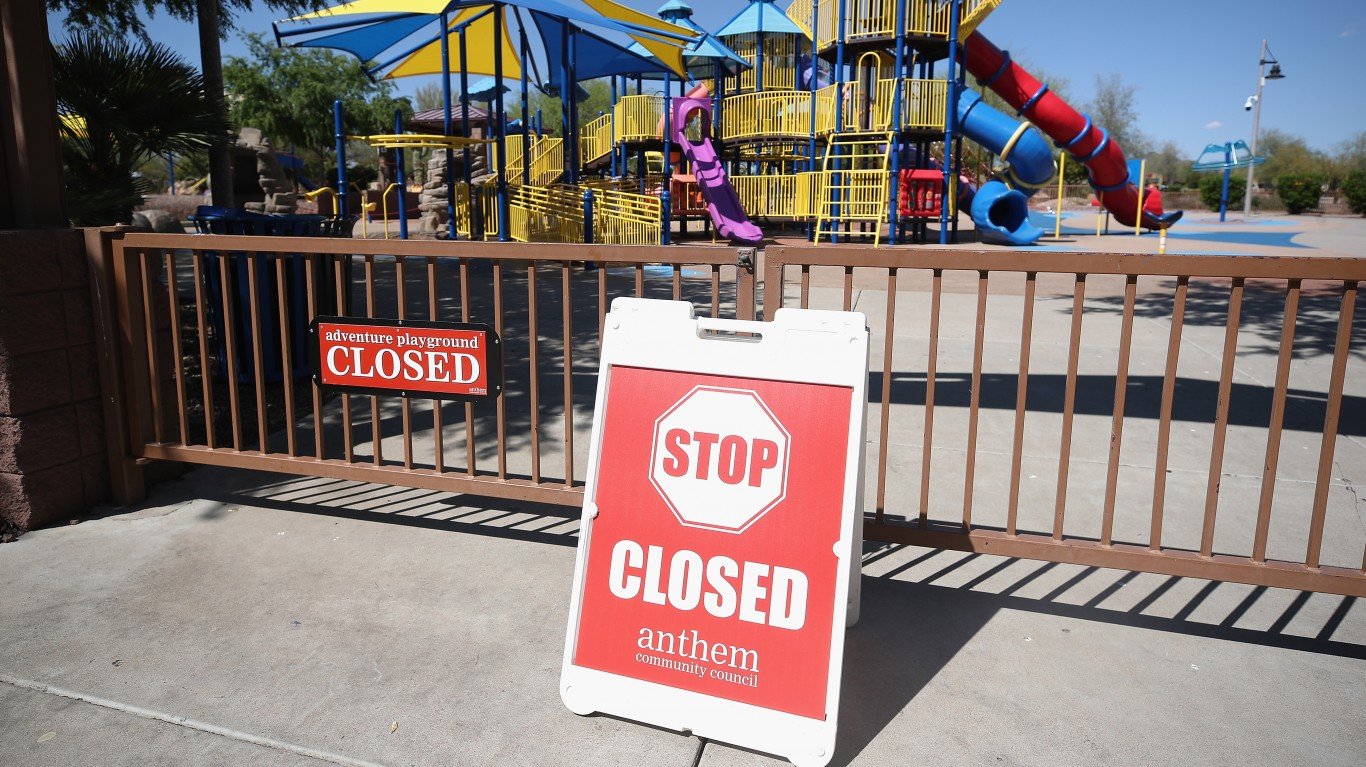
1. Arizona
> Death rate: 459 per 100,000
> Total deaths: 33,417 – 11th highest
> Cases per 100,000: 33,956 – 15th highest
> Total cases: 2,471,546 – 13th highest
> Population, 2021: 7,276,316 – 14th highest
Sponsored: Want to Retire Early? Here’s a Great First Step
Want retirement to come a few years earlier than you’d planned? Or are you ready to retire now, but want an extra set of eyes on your finances?
Now you can speak with up to 3 financial experts in your area for FREE. By simply clicking here you can begin to match with financial professionals who can help you build your plan to retire early. And the best part? The first conversation with them is free.
Click here to match with up to 3 financial pros who would be excited to help you make financial decisions.
Thank you for reading! Have some feedback for us?
Contact the 24/7 Wall St. editorial team.
 24/7 Wall St.
24/7 Wall St.